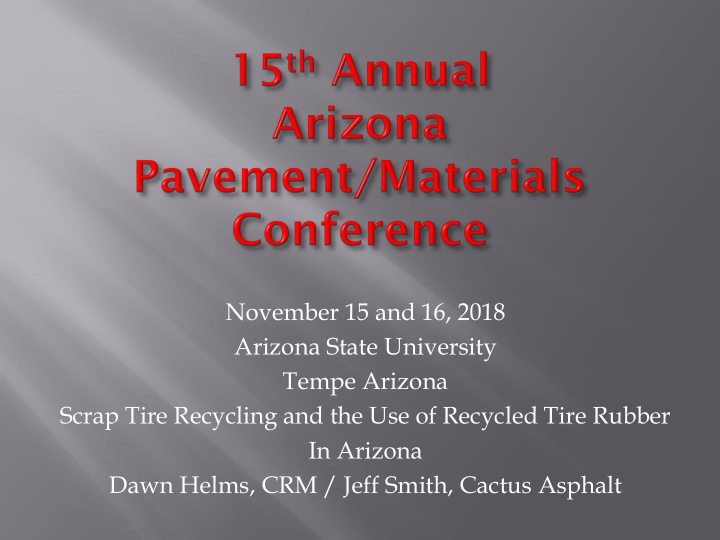



November 15 and 16, 2018 Arizona State University Tempe Arizona Scrap Tire Recycling and the Use of Recycled Tire Rubber In Arizona Dawn Helms, CRM / Jeff Smith, Cactus Asphalt
Dawn Helms CRM of America, LLC
Arizona’s Model Waste Tire Program By The Numbers Components of a Successful Program Vibrant Industry
AZ generates approx. 13 million scrap tires per year $2.00 recycling fee for each tire purchased Tire retailers keep $.10 per tire to cover record keeping DEQ receives 3.5% per year to enforce the tire laws Remaining funds distributed to counties based on registered vehicles Each County must build and maintain a Waste Tire Collection Site Disposal programs determined and administered by the counties
Apache – 20,000 Cochise – 150,000 Coconino – 140,000 Gila – 75,000 Graham – 40,000 Greenlee – 5,000 La Paz – 113,000 Maricopa – 6,700,000 Mohave – 308,000 Navajo – 104,000 Pinal – 250,000 Pima – 1,400,000 Santa Cruz – 110,000 Yavapai – 250,000 Yuma – 335,000 TOTAL: 10,000,000 * Purchase Order
Total of waste tires for recycling 10,000,000 PTE’s (Passenger Tire Equivalent) Total PTE’s generated in AZ per year 13,000,000 PTE’s Difference is approx. 2,000,000 PTE’s out of the system - culled and sold as used tires Fun Fact: 10 Million PTE stretches approx. 4,735 miles or approx. half way around the earth
What Makes a Successful Waste Tire Management Program? • Closed Loop Partnerships • Industry Expertise in Manufacturing Methods and Logistics • Market Development • Product Diversification • Commitment to Environmental Stewardship
Closed Loop Partnerships Closed loop partnerships support a common environmental responsibility goal – A strong waste tire management program (Collection) – A strong waste tire recycling program (Recycling) The last chain in the closed loop process is purchasing – The use of the recycled waste tires as crumb rubber in products such as asphalt rubber and artificial turf infill
State-of-the-art recycling/manufacturing facility with the largest capacity in Northern America Utilizes varied processing methods to meet customers crumb rubber requirements; ambient and cryogenic production Industry expertise in waste tire recycling, manufacturing, technology, marketing, and logistics A company mission of environmental stewardship
120,000 sq. ft. plant on 40 acres in East Maricopa County Artificial Turf Landscape
AmericanRecycler.com by Irwin Rapoport (NOV 2008) Arizona tire pile problem remains unresolved “The Arizona Department of Environmental Quality has now passed legislation requiring privately-owned facilities with more than 500 tires to submit site plans. “
Portrait of An Unsuccessful Waste Tire Management Program “Tire Failure” Lax rules left mountains of mosquito-infested, flammable tires in South Carolina • By Tony Bartelme and David Wren tbartelme@postandcourier.com dwren@postandcourier.com • Apr 22, 2018
El Paso, TX Cleanup efforts at massive El Paso County tire dump a costly challenge, owner says By: matt.steiner@gazette.com Aug 31, 2016 “Tires had piled up for more than two decades after the dump began in the 1980s. Six years ago, the dump had an estimated 30 million tires in stacks above ground and buried 30 feet underground”.
Colorado’s Tire Mountain “The Midway Tire Monofill is the second largest in Colorado, which has three such dumps. A facility, owned by CH2E in Hudson is the biggest, Gaboriau said. The third monofill in Colorado is run by Resources Management Co. and is located in Julesburg. Gaboriau said CDPHE estimates the three facilities combined are filled with more than 60 million tires .” By: matt.steiner@gazette.com Aug 31, 2016
Waste Tire Recycling is more than an environmental program, it has become a VI VIBR BRANT ANT IN INDUS DUSTRY TRY Adding Millions to Arizona’s economy with….. Vendor Transport jobs Revenue wor k Supplier Research Technology transfer
Jeff Smith Cactus Asphalt
Charlie McDonald and A- R “Band - aid” Circa 1966
Early Asphalt-Rubber Binder Mixing – Circa 1972
Early Spreader Truck Technology – Circa 1973
Next Generation Rubber Blending Technology – Circa 1992
New Spreader Truck Technology
SAM SAMI DENSE-GRADED HOT MIX OPEN GRADED HOT MIX GAP GRADED HOT MIX 1960 1970 1980 1990 2000 2010 Present
SAM (Chip Seal /LV and HV FAST) SAMI (Interlayer) Cape Seal (Slurry, Micro and Premium Seal Coat) Hot Mix (Gap and Open Grade) Scrub Seal (Hot Applied) Four Binder Materials Available (Arizona Rubber) Polymer Modified Asphalt Rubber Asphalt Rubber Rubberized Asphalt Binder Rubberized Asphalt Scrub Seal
Cape Seal (Premium Seal Coat)
Usually 82 to 85 Percent of PG Asphalt Cement and 15 to 18 Percent of 12 to 14 Mesh CRM and Fine Grind SBS Polymer Combination _________________________________________ FAST Application Rates PMAR Binder - .60 to .75 Gallons Per Square Yard 3/8" to 1/2" Aggregate – 26 to 32 Pounds Per Square Yard
Usually 80 to 85 Percent PG Asphalt Cement and 15 to 20 Percent of 12 to 14 Mesh CRM or a Combination of CRM and High Natural Rubber ________________________________________ FAST Application Rates A-R Binder - .55 to .75 Gallons Per Square Yard 3/8" to 1/2" Aggregate – 26 to 36 Pounds Per Square Yard Currently Utilized as a Hot Mix Binder
Usually 89 Percent PG Asphalt Cement and 11 Percent of Fine Grind CRM and Fine Grind SBS Polymer Combination _________________________________________ FAST Application Rates RAB Binder - .30 to .50 Gallons Per Square Yard 1/4" to 3/8" Aggregate – 18 to 28 Pounds Per Square Yard Has been utilized as a Hot Mix Binder
Usually 86 to 90 Percent of a Low Penetration Asphalt Cement and 10 to 14 Percent of a Fine Grind CRM and SBS Polymer Combination ____________________________________ Application Rates Binder - .20 to .50 Gallons Per Square Yard Aggregate or Sand – None Required
Mohave County Maricopa County City of Glendale
Questions?
Recommend
More recommend